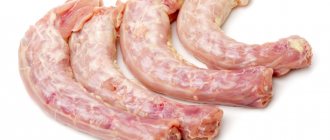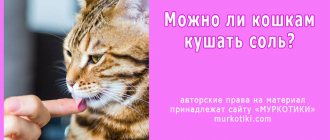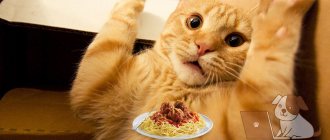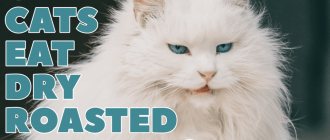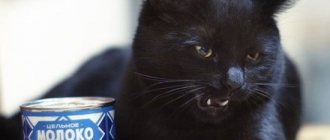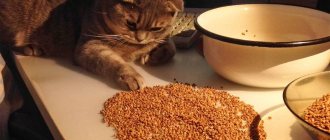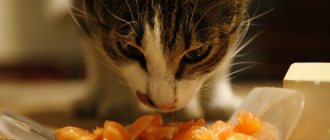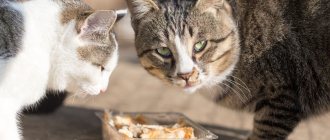It’s good when a cat owner thinks about nutritious nutrition for his pet. After all, the digestive process of cats is significantly different from the digestive process of humans. Only now the majority makes a choice in favor of industrial feed. Because they do not require time to prepare and their composition is balanced by specialists. That's right, but fresh homemade food is much healthier, and in case of health problems, it is certainly better to prepare food yourself, in consultation with a veterinarian.
Please note: this article offers only a few healthy and proven recipes, not a complete long-term menu.
Basic rules for healthy cat nutrition
- About 90% of the diet should consist of meat and offal.
- Cat dishes are served raw (with the exception of some products, which will be discussed separately) and at room temperature. It is advisable to defrost frozen portions at room temperature.
- After preparing raw meat portions, place them in the freezer for at least three days. Freezing kills almost all dangerous bacteria and parasites.
- Buy meat only from a trusted place.
- Food should contain bones or calcium supplements.
- Most of the diet should be offered in the form of pieces, since the pet must work with its jaws, tear and chew food. This is important for the cat’s health and prevents problems with teeth and gums.
- Clean water should be freely available.
- It is necessary to follow the feeding regimen and not exceed the portion size. An adult animal is fed twice a day, in the morning and late in the evening. The daily norm for a domestic, sedentary pet is approximately 50 g/kg of weight.
A cat's menu is much poorer than a human's. Cats are absolute predators; under natural conditions, very few grains and barely noticeable amounts of vegetables enter their stomachs. Therefore, no matter how healthy porridge, raw and baked vegetables may be for humans, they should not be included in your pet’s diet. We advise you to read the article, which describes in detail foods that are harmful to your cat’s health.
One of the easiest to prepare dishes that are most similar to natural food are raw chicken heads and necks. Some people do not believe and are even horrified that their cute cat is able to greedily bite into a chicken head and not choke on the bones. But it is the bones of the heads and necks that the cat will gnaw without harm to health. Moreover, such nutrition will bring a lot of benefits to the animal. Heads and necks require treatment before feeding, but this is not difficult to do.
Don't give too often
Is it possible to feed a cat chicken stomachs every day? Despite all the usefulness of this product, you should not make it the basis of your diet. According to experts, by-products in a cat’s diet should make up no more than 30%, the remaining 70% being muscle meat. So you should give chicken gizzards no more than twice a week.
When stocking up on provisions, keep in mind that it is recommended to store meat and offal in the freezer for no longer than 3 months, because over time they lose their beneficial properties.
The widespread opinion that you cannot feed a cat both industrial dry food and natural fresh food at the same time has recently been actively refuted by veterinary nutritionists. There is no fundamental difference in the absorption of a dehydrated product and food with a natural moisture content.
The only important question is the individual reaction to one or another component, which can be found in both a dry and natural diet, as well as the balance of the latter in all nutrients.
How to Prepare Chicken Heads
Most often, such products are sold in frozen packages. Wait for the heads to thaw. Then you need to rinse them with cool water, cut off the beaks (they are too tough for a cat), and cut them in half lengthwise. This will not require noticeable physical effort.
If the head is small and the pet is large, you don’t have to cut it - more nutrients will be retained in the product. Then the halves are put into portioned boxes or cups. You can use plastic cups with a volume of 200 ml, the same volume as sour cream and mayonnaise boxes. One such serving will last a medium-sized adult domestic cat for the whole day.
How to properly feed a cat natural food?
Frequency of application
- Raw frozen beef – (for a kitten at least 30 grams, for an adult cat – 100-120 grams). ...
- Boiled chicken without bones...
- Chicken or beef by-products (heart, lungs, liver, kidneys) raw (frozen) or boiled. ...
- Boiled fish, lean, boneless, preferably sea fish (not often, because...
Interesting materials:
Do I need to remove the sticky layer with primer? Do I need to remove the film from polycarbonate on both sides? Do I need to remove ceiling tiles before installing a stretch ceiling? Do I need to withdraw from the labor exchange? Should I put a dash after this? Do I need to get a flu vaccine? Do I need to trim my guinea pig's nails? Do I need to cut my parrot's claws? Do I need to dry gel polish in a lamp? Is it necessary to dry pipe tobacco?
How to prepare chicken necks
Necks, like heads, are often sold frozen and in packages.
As with the heads, they need to be thawed, rinsed with water and cleaned of skin and fat (the fat contained in any meat, but not visible to the naked eye, is quite enough). Then they need to be cut into pieces 1.5 - 2 cm long. The necks are quite easy to cut, you just need to try to guide the knife blade between the vertebrae. Instead of cutting into pieces, you can flatten the necks a little with a hammer. Then also distribute into portioned containers and freeze. For variety, it’s a good idea to form portions of heads and necks in a 50/50 ratio. Important!
A cat that is accustomed to human food or industrial feed is unlikely to be happy about changing its usual diet to heads and necks. You can learn how to correctly transfer a pet from one type of food to another in the article How to transfer a cat from commercial food to natural food (or vice versa).
Chicken hearts: benefits and harms
The beneficial qualities of the product are associated with its multicomponent composition. In terms of the amount of amino acids and microelements, hearts are superior to other offal products. Vitamins from group B and PP promote good blood circulation and metabolism, stimulate the central nervous system, normalize liver fat metabolism, strengthen the immune system, and increase brain activity. Vitamin A will help strengthen your pet's vision. Retinol, which is part of the hearts, improves the skeletal system, skin and hair. The mineral composition has the following effects:
This product has a positive effect on the condition of the animal’s claws, as it contains everything necessary for their growth.
- normalizes the growth of claws and fur;
- promotes insulin production;
- improves heart function;
- stabilizes blood pressure.
The amino acids contained in the hearts will help normalize blood glucose levels, restore skin and muscle cells, and strengthen bones. In addition, they are able to remove toxins, improve immunity and cope with fat deposits. However, despite the positive qualities of the product, there are also negative aspects. One of them is cholesterol, which can be harmful to your cat's health. This is why you should not feed your pet chicken hearts often. There is also a kitten intolerance to the product. Some animals outright refuse to eat this product, as well as the feed that contains it. Vomiting and diarrhea are common after consumption.
Cooking fish
Only sea fish will do; river fish has too many bones. It needs to be boiled for a few minutes. Then cool and remove bones completely. One serving - no more than 150 g. You can put a raw quail egg in the fish. Although many cats simply love fish, it is not advisable to give it more than once every five days. Fish contains a lot of phosphorus and magnesium; its frequent presence in the diet upsets the balance of minerals in the cat’s body. This can provoke many diseases, primarily KSD.
Can a kitten have chicken stomachs?
Of course you can! Chicken stomachs will be no less useful for a kitten than for an adult animal, because it is an excellent source of protein, potassium, iron, zinc, phosphorus, as well as vitamins B, E and folic acid. Regular consumption of this product makes the diet more diverse in chemical and amino acid composition.
Experts recommend introducing by-products upon reaching two months and giving them once a week. Chicken stomachs can be offered to kittens in finely chopped or ground form. If your baby refuses unusual food, mix it with other foods that he eats more readily.
Elena Shlykova
Meat mix
Any meat products in arbitrary proportions from those allowed are suitable for this dish. And the more of them, the better. For example: chicken breast, turkey and chicken stomachs, chicken heart. Everything is rinsed with cool water. Then the following are removed: from the hearts - pieces of fat, from the stomachs - hard connective fibers. After which the products are chopped into pieces measuring about 1 ╳ 1 cm. As in the case of heads and necks, the mixed cuts are placed in 200 ml portioned containers and sent for freezing.
Are you still feeding your pets chemicals? - Then we go to you! (MK on PP for cats)
The backstory of your cat dolls, as well as the history (it’s just the beginning), can be read separately. I will only say one thing - when I took my double happiness home, I already knew: I would feed _these_ correctly and with natural food. I found the recipe on a specialized forum. It is not necessary to follow the exact recipe, the main thing is to observe the approximate proportions and composition of the products “on average” - so that the animal can easily receive from food absolutely all the necessary vitamins and elements for a happy, healthy and long life. Let me remind you right away: cats are predators, “our” food is completely unsuitable for them. So, let's go! The original name is “Kunina porridge”. And today we will have - “Zhopysrukkina porridge”
***this will be a long, but fascinating post***
What we need for cooking: (very)
a large saucepan (as a mixing container), a meat grinder with large holes, a frying pan, a board, a knife, a hammer for beating, a cutting board.
Products. The ideal option for a cat is “bloody” offal, especially heart and liver, as a vital source of taurine. This is the basis. Cats do not need fiber and carbohydrates as such - but they participate in the formation of the necessary flora, and they also add volume to the porridge. I'll tell you about the rest as we go.
What's on the table: veal liver - about 650 g chicken hearts + chicken liver - about 550-600 g each veal heart - half pork heart - 1 piece Each piece of veal and pork lung (last time this place was pork kidneys or spleen) chicken necks without skin - approx. 650 g veal brisket with cartilage - 2 small pieces (last time it was a turkey leg) crucian carp meat - 4 pieces, cleaned and gutted just in case, cut off a large fin (sharp) (last time there was in general, some kind of ungutted small fish like capelin) Ideally, there should be good sea fish: Pumpkin (about a kilogram, I took chopped ones), carrots - 4 large pieces (last time there was also unpeeled zucchini, and less pumpkins) pig ears and nickels - 2 pcs each (ideally, of course you need chicken scallops, but where can you find them) olive oil kelp
We turn on our favorite movie/pederaca/music and start playing. Ideally, it should be cut into small pieces - but it can be done just as well. If you have a combine harvester with a large crusher, it will probably be incomparably easier.
smoking hearts and livers. I alternate products according to “consistency” so that later it will be more convenient to mix
veal heart - without fat. cut it off and throw it away, it’s definitely not good for cats
whole pork - remember about “bloody”! Fresh, it was grunting this morning (I took it at the fair) Taurine - kitten FSIO.
lungs - pork on the right, veal on the left.
crucian carp - purely for “beauty”. There was pangasius and capelin, but we still didn’t have salmon as is, with head and all. It’s a pity, 3 out of 4 were with caviar, but I already threw them out with all the entrails - “out of harm’s way”
We gradually pour everything twisted into one container. I have a hefty saucepan, now the volume is already approaching 3 liters
Chicken necks. A vital thing for cats. 1) calcium from seeds; 2) teeth should work too. And there are no sharp bones in the necks - your pet will not get hurt. For adult cats, and when there is an opportunity, they simply give them the whole neck - let him gnaw. The kids are beaten and cut. My house is small, my little butts with one half-gnawed neck fill up the entire space. Therefore, everything at once is a mess.
We beat back. Beating is actually very easy and quick - the chicken vertebrae crumble well.
And - into the meat grinder. This is what broken necks look like (right)
The brisket is also cut right with the cartilage - and there too.
Ears and nickels are a valuable source of collagen, especially for growing kittens. By the way, in terms of cost per kg, this is perhaps the most expensive part of a kitten’s diet: a pair of ears - 15 UAH, nickels - 10 each (for Russians, 1 dollar = approximately 8 UAH). Cut it smaller
This is what they look like twisted
Calf liver comes last - then the cartilage will better mix with everything else (this is already from practice)
while such a tub is being drawn. But that is not all
By the way, here they are with their assholes - they are watching.
Now it’s the turn of vegetables. I was too lazy to peel the carrots, so I cut off the butts and washed them. There - into the meat grinder.
In the meantime, take a big frying pan and generously pour in olive oil - after all, we’re already making a ton of porridge! There is no need to explain why olive oil is needed, I think. If you don’t have it, then either don’t stew it at all, or do it with water; sunflower oil is not allowed for cats. Ideally, you should drip the oil separately into the finished portion, but I’m too lazy, so let’s simplify the process
throw carrots in there
and start chopping the pumpkin
And - right there in the frying pan
Add a little water - “simmer” - this is literally 5-10 minutes and mix everything properly 2-3 times. Just so that it softens, and the cunning assholes don’t pick out the meat separately and the vegetables separately.
While it's in the frying pan, you have time to finally wipe the blood off the battlefield, put things in order on the table, and get the kelp. It is necessary, cats in this form absorb the iodine they need well. I don’t have sea fish, and there was no powder in the pharmacy either - so we take 1 blister, scoop out the tablets and grind them in a mortar. By the way, you can also take sushi sheets - they also work well. I forgot to take a photo of this right away - there is no mortar, there is a cup and a potato masher. Voila!
By the way, in this place - cutting grass - I also tried out a new ceramic knife. Well. Don't know. It's good that I didn't buy the set right away.
Pour everything into the same pan, gracefully distribute the crushed kelp on top
And then the vegetables arrived. I poured everything into one pile and wondered how to mix it now. "
. and realized that this time I need to take a basin
I even weighed it - it came out to 6.5 kg. The total cost is approximately 100 UAH, maybe a little more. This is without the cost of oil and tablets. Absolutely balanced, healthy food. Now all that remains is to pack this thing into cups. Also sorry, I forgot to take a photo right at the beginning
There are about three of these spoons for each glass. Last time I put in 2 spoons, but the girls are growing up, lately they haven’t even had enough 2 cups a day, they needed three.
Freezing is a must!! The fact is that during subsequent defrosting, the protozoa (if any) burst. Profit.
I fill the defrosted portion with yogurt without sweet additives. This time there was activity. I don’t take it often - because it manages to turn sour before the asshole’s hand “finishes” it. I usually take something smaller. Yogurt or kefir is needed, firstly, as a source of fermented milk, and secondly, the “porridge” under the yogurt does not get soggy, and cats are happy to lick the bowl clean. But mine categorically refused kefir, so - yogurt.
We survey the “battlefield”
And we put the food in the freezer
I spent an hour and a half on everything without straining myself, listening to the wonderful “X-Factor”, watching yesterday’s live broadcast on the Internet. This will last us about 3 weeks. I also give them hard cheese (rarely, speckled), I can smear butter on their noses, once a week I give them an egg, 10% cream is freely available. Sometimes they wake up. I don’t know what wakes them up - but they ask for sweets; the son is happy to share a cake or pancakes
My cat dolls are now 4.5 months old. The bead weighs 2600, the Matryoshka 2400. They are satisfied and happy, and love me almost as much as I love them. And I just LOVE them!
PS The main advantage of such a “porridge” was revealed quite unexpectedly. They hardly drink water (the moisture they get from meat is enough for them) and - most importantly. - they have no smell
toilet. At all . I had the opportunity to compare. Those. At first I didn’t pay attention - well, it’s nice, since it doesn’t stink, then what should I think about it? And then the porridge in the freezer ran out, and there was so much work to do, there was really no time to run around the store-bazaar, buy ingredients and stand around twisting and packaging - I ran out and bought Royal Canin for the kittens. MOTHER, at first I didn’t even understand why such a smell came from the pot. (lost the habit) And then it came.
Substitute Products
You can treat your pet to boiled fish, but not often.
Veterinarians say that it is better for the cat to eat other foods that contain no less useful components instead of a chicken bone. You can replace bone mince with the following dishes:
- Fish. When a cat eats such a product, you should also carefully monitor it so that it does not choke on the bone. It is strictly forbidden to replace the main food with it; fish should only serve as an additive. It is allowed to feed your pet this dish 1-2 times a week, but it is allowed only in boiled form.
- Special bones. They consist of tendons and movable joints in crushed form, as well as beef stomachs.
It is best to give preference to specialized dry food for cats, which must be given to the animal in a certain dosage. This food is as balanced as possible, since it contains all the beneficial microelements in the quantities necessary for the cat’s body. When purchasing a product, the age and health of the pet are taken into account. It is equally important to read the composition of the product, because if it contains flavorings, preservatives and salt, then you should not choose such dry food. It is important for the owner to understand that only premium and super-premium products will be useful. If your cat still wants to eat chicken bones, then you should give them with leftover meat and cartilage. In this case, the pet will satisfy its hunting urges and will not cause harm to the body.
Why can't a cat eat bones?
Sometimes fragments of such food can get stuck between the animal's teeth.
If a cat ate chicken paws or other bones once, then perhaps nothing bad will happen, but when an animal constantly eats broken chicken bones, serious health problems are possible. The seed does not have any nutritional value, but contains many useful microelements. This is the only benefit to feeding your cat chicken bones. In most cases, such a component in a cat’s diet can have dangerous consequences, even if the bones are boiled or made into bone mince. Such a diet threatens the following disorders:
- mechanical damage to the mucous membrane of the mouth, esophagus, stomach or intestines;
- hard pieces getting stuck between the teeth, which leads to gum injury;
- blockage of the digestive tract.
Tubular bones and chicken feet pose a particular danger to a cat's health. This is due to the fact that such parts have sharp edges that severely injure the mucous membrane. Spongy components are less dangerous, but can still provoke an inflammatory reaction or blockage of the esophagus. In the latter case, the cat exhibits the following unpleasant symptoms:
- constipation or diarrhea with blood in the stool;
- lethargic state;
- problems with appetite;
- repeated vomiting;
- copious amounts of saliva;
- pain during bowel movements.
Should I give raw or boiled meat?
Cats are carnivores, and in the wild no one cooks food for them, so the digestive system of pets can handle raw meat quite well. Therefore, such food is physiologically closer to cats. Another thing is the individual preferences of animals, which depend on what food the animal has been accustomed to since childhood.
Read also: Yoga blocks. What are they needed for
Chicken meat is extremely rarely infected with helminths, so in this regard, a cat eating raw chicken is not in danger. Fish and other types of meat pose a great danger - for example, pork, which veterinarians generally do not recommend giving to cats.
Why is salmonellosis dangerous?
The disease is always severe and accompanied by severe symptoms. You can observe in your pet:
